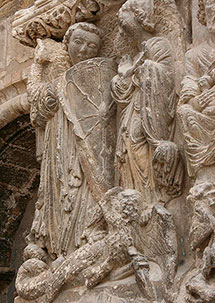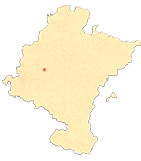La Portada de San Miguel de Estella
The artists
The doorway of San Miguel de Estella is no exception to the general anonymity of Romanesque artists. We know almost nothing about their persons or their life circumstances. Only comparative analysis provides elements that give clues about their training. Of course, the dimensions and complexity of the work as well as certain differences in the treatment of anatomies, folds, proportions and expressions reveal that several sculptors collaborated. It is possible that the large-headed figures of the capital of the Annunciation were carved by different hands from those responsible for shaping the slender figures of the Magi. Nor do the gentle, oval faces of the angels on the slabs seem to have come from the same chisel that carved the rougher, more dour, square-jawed apostles. However, as is usual in medieval commissions of a certain complexity, a good issue of figures share familiar features, possibly result from following the initial drawings proposed by the workshop manager.
Scholars have stressed the links of these reliefs with those of other late-Romanesque artists who worked on the Iberian Peninsula. Debts have been pointed out with the second workshop of the cloister of Silos, one of whose masters may have been the one who introduced into the sculpture the novel archangel Gabriel who bends the knee before Mary in the Annunciation. This is a detail charged with meaning: the angelic creature recognises the superiority of the one chosen to be the Mother of God. In Silos the gesture finds its raison d'être in the coronation of Mary that other angels stage. In the Estella Annunciation Mary does not wear a crown (she does in the Adoration of the Magi). Whoever carved the Estella capital dispensed with the impossible kneeling turn of the Silense archangel (inspired by Byzantine precedents, as Dulce Ocón analysed), but it is certain that another impossible gesture appears in the seated angel of the Navarrese slab of the visitatio sepulcri. Similarly, the abundant folds of the stellate figures combined with drop-shaped designs reveal their Byzantine descent, an artistic trend which in the West reached its peak in the Sicilian mosaics. Although it should not be forgotten that the Infanta Margarita, sister of Sancho VI the Wise of Navarre, was Queen of Sicily and mother of William II (promoter of the cathedral of Monreale), it is certain that the sculptural aspect of Byzantinism had already been present in Silos and was manifested in other Navarrese works (Tudela). Some of the sculptors who worked on San Miguel carried out other sculptural commissions in churches near Estella, such as Eguiarte, Lezáun and Azcona.











